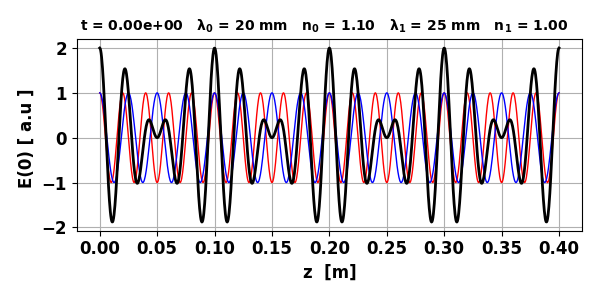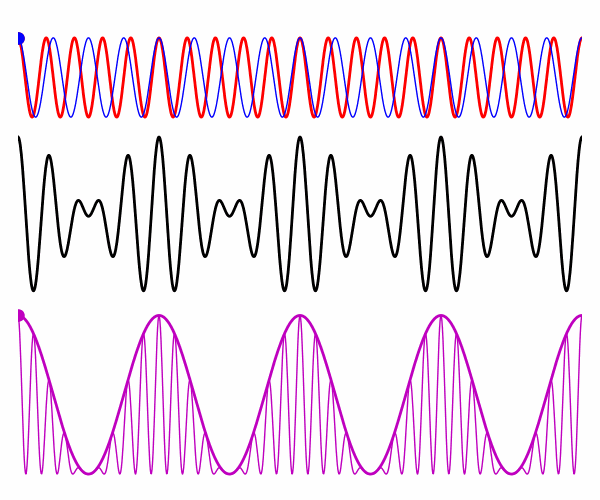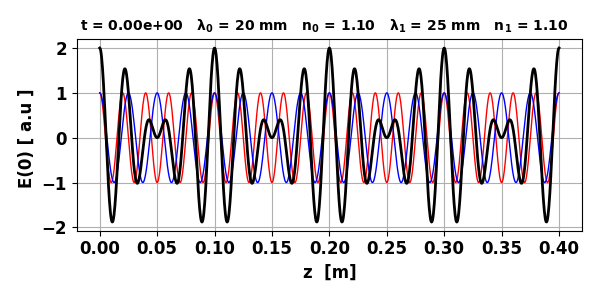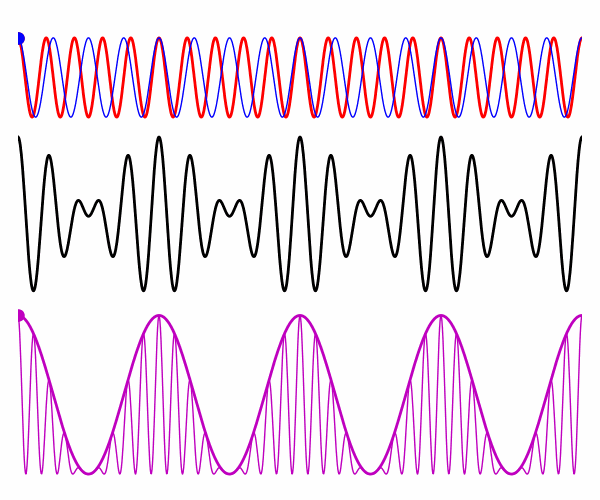|
[1D] SUPERPOSITION OF PLANE WAVES Ian Cooper Please email
me any corrections, comments, suggestions or additions: matlabvisualphysics@gmail.com DOWNLOAD DIRECTORIES FOR PYTHON CODE emPW01.py It turns out
that any optical field (e.g. pulses or a focused beam), regardless of how complicated, can
be described by a superposition of many plane wave fields. In this article, we
develop the techniques for superimposing plane waves. We begin our analysis
with a discrete sum of plane wave fields and show how to calculate the
intensity in this case. We will introduce the concepts of phase velocity and
group velocity. The group velocity
describes the motion of interference ‘fringes’ or
‘packets’ resulting when multiple plane waves are superimposed. We can construct
arbitrary waveforms by adding together many plane waves with different
propagation directions, amplitudes, phases, frequencies and polarizations. The
superposition of the electric fields for plane waves expressed as a descrete
sum is given by (1) We will consider the situation where all plane-wave
components travel roughly parallel to each and assume that the (2) Note: distinction between irradiance S and intensity I . For example, 〈irradiance〉 is zero for standing waves because
there is no net flow of energy, whereas equation 2 still gives a result for
the intensity. Intensity specifies whether atoms locally experience an
oscillating electric field without regard for whether there is a net flow of
energy carried by a light field. To begin our study of interference,
consider just two plane waves propagating in the +Z direction with equal
amplitudes given by (3) The phase velocities vp (velocity of the wave crests) for
the individual plane waves are (4) Next consider the complex (resultant)
wave created from the superposition of the above two plane waves (5) The two plane waves interfere,
producing regions or fringes of
higher and lower intensity that move in time. Remarkably,
these intensity peaks of the resultant wave can propagate at speeds quite
different from either of the phase velocities of the individual waves. The
time-averaged intensity of the
complex waves travels with velocity know as the group velocity
vg
(6)
The group velocity may be thought
of as the velocity for the envelope that encloses the rapid oscillations. For
dispersive media, the phase and group velocities are generally different. The Python Code emPW01.py is used to visualize the propagation of the two plane
waves and the resulting complex wave. The input parameters are the number of
grid points, the wavelengths (microwave wavelengths) and refractive indices. #%%
INPUTS num = 999 # Grid points N = 2; wL = zeros(N); n =
zeros(N) # Wavelengths wL [m]; wL[0] < wL[1] wL[0] = 20e-3; wL[1]
= 25e-3 # refractive indices n: n[0] > n[1] # longer wavelength must
have a lower value for refracticve its refractive
index n[0] = 1.1; n[1] = 1.00 #%% CALCULATIONS c = 3e8
# speed of light k = 2*pi/wL #
propagation constant w =
c*k/n
# omega: angular frequency T = 2*pi/w[0] # period wave
1 vP = w/k
# phase velocities vG = (w[1] - w[0]) / (k[1]- k[0]) L = 20*wL[0] # Z axis range z = linspace(0,L,num) F = 200; t = linspace(0,20*T,F) # Spatial
electric field at time ts ts = 0*T # ts = 0 for animation E0z =
exp(1j*k[0]*z)*exp(-1j*w[0]*ts) E1z =
exp(1j*k[1]*z)*exp(-1j*w[1]*ts) Ez = E0z + E1z S = 0*Ez #
intensity #%% wp = (w[0]+w[1])/2; kp = (k[0]+k[1])/2 wg = (w[0]-w[1])/2; kg =
(k[0]-k[1])/2 vG = wp/kp The results of the calculations are displayed in the Console Window wL0 = 0.020
m wL1 = 0.025 m n0 =
1.100 n1 = 1.000 m vP0 =
2.727e+08 m/s vP1 = 3.000e+08
m/s vG = 1.636e+08 m/s vR = 2.864e+08 m/s A plot of the electric fields at time ts and as an animation of the time
development of the electric fields and intensity are displayed in the Figure Windows.
Fig. 1. Dispersive
medium: electric fields at time t = 0.
Fig.2. Dispersive
medium: electric fields for the two plane waves, resultant electric field,
intensity, and intensity for the time-averaged over the rapid oscillations. vP0 = 2.727x108
m/s vP1 = 3.000x108 m/s vg = 1.636x108 m/s vR = 2.864x108 m/s The rapid oscillations in the intensity corresponds to the Poynting
flux where the rapid oscillation peaks in figure 2 move with a phase velocity
vR derived from the average
(7) The group velocity vg may be thought of as the velocity for the
envelope that encloses the rapid oscillations. In general, vg and vp are not the same. This means that as the
waveform propagates, the rapid oscillations move
within the larger modulation pattern, for example, continually disappearing
at the front and reappearing at the back of each modulation. The group
velocity is identified with the propagation of overall waveforms. Figures 3 and 4 shows the propagation of the plane waves in a
non-dispersive medium where n1 = n2. In this case the phase velocities, group velocity
and the velocity of the rapid fluctuations in intensities are all equal. wL0 = 0.020
m wL1 = 0.025 m n0 =
1.100 n1 = 1.100 m vP0 =
2.727e+08 m/s vP1 = 2.727e+08
m/s vG = 2.727e+08 m/s vR = 2.727e+08 m/s
Fig. 3. Non-dispersive medium: electric
fields at time t = 0.
Fig. 4. Non-dispersive
medium: electric fields for the two plane waves, resultant electric field,
intensity, and intensity for the time-averaged over the rapid oscillations.
vP0 = vP1 = vG = vR = 2.727x108 m/s |







